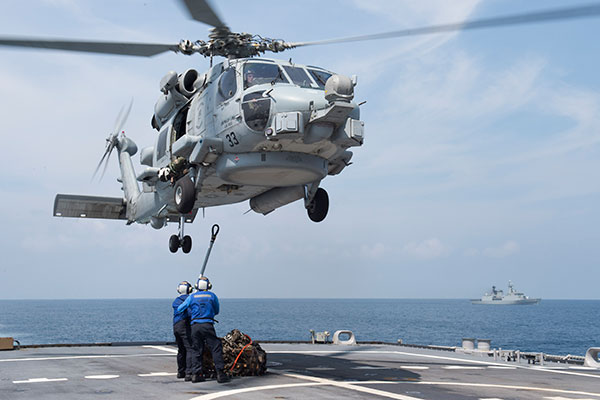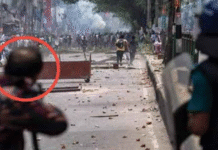The 5th annual exercise Cooperation Afloat Readiness and Training (CARAT) Bangladesh came to a close at Naval Base Issa Khan, Oct. 4.
CARAT Bangladesh 2015 consisted of five days of shore-based and at-sea training events designed to address shared maritime security priorities, develop relationships and enhance cooperation among participating forces.
“We see CARAT as one of the U.S. Navy’s best opportunities to address shared maritime security concerns, develop relationships and enhance interoperability,” said Capt. H.B. Le, commodore, Destroyer Squadron 7. “Now in our fifth year working together, CARAT Bangladesh has become the premier engagement between our navies.”
In its 21st year, CARAT is a bilateral exercise series between the U.S. Navy and the armed forces of nine partner nations in South and Southeast Asia, including Bangladesh, Brunei, Cambodia, Indonesia, Malaysia, the Philippines, Singapore, Thailand, and Timor-Leste. Though a relatively new participant, Bangladesh stands out as the only South Asian nation in the CARAT series and the exercise continues to make steady progress each year.
Training events in each CARAT phase are tailored based on available assets and mutual exercise goals across a broad range of naval capabilities. For the first time, USS Fort Worth (LCS 3) participated in CARAT Bangladesh. During his closing remarks, Capt. Le talked about the importance of Fort Worth’s participation.
“This year the littoral combat ship USS Fort Worth, one of our navy’s newest and most advanced ships, participated in CARAT Bangladesh,” said Le. “Her presence was important as this was the first CARAT since 2012 that we had a US Navy ship and crew training at sea with the professional and skilled Sailors from the Bangladesh Navy.”
During the sea-phase portion of CARAT, sailors from the Bangladesh Navy trained aboard Fort Worth and participated in a simulated vertical replenishment (VERTREP) exercise. Replenishment at sea (RAS) approaches were also conducted between Fort Worth and two ships from the Bangladesh Navy, the BNS Abu Bakr (FF-15) and the BNS Bangabandhu (FF-25).
“Being able to sail with the professional Sailors from the Bangladesh Navy on board Fort Worth during CARAT was extremely valuable for both navies,” said Cmdr. Christopher Brown, USS Fort Worth’s commanding officer. “Not only did our Bangladesh Navy partners get to witness first hand Fort Worth operate at sea, they were able to actively participate in the exercises with the crew while embarked. This type of training goes a long way towards interoperability at sea, which benefits the shared security interests of both navies.”
U.S. Navy divers and Explosive Ordnance Disposal (EOD) technicians also trained alongside the Bangladesh Navy’s elite Special Warfare Diving and Salvage (SWADS) unit in Chittagong and the surrounding area. Close quarters battle, small boat maintenance, demolition techniques, hydrographic surveys, diving medicine, and salvage operations were the focus areas of the training.
Additionally, in the Bay of Bengal, the diving and salvage vessel USNS Safeguard (T-ARS 50) with an embarked mobile diving and salvage unit, worked with Bangladesh Navy divers.
U.S. Navy units also participating in CARAT Bangladesh included the diving and salvage ship USNS Safeguard (T-ARS 50) with embarked Mobile Diving and Salvage Unit (MDSU) 11-7, a P-3C Orion maritime patrol aircraft, staff from Commander, Task Force (CTF) 73 and Commander, Destroyer Squadron (DESRON) 7, Afloat Training Group Western Pacific (ATGWP), Explosive Ordnance Disposal Mobile Unit (EODMU) 5, and Navy Environmental and Preventative Medicine Unit (NEPMU) 6.
Commander, Task Force 73 and Destroyer Squadron 7 staff conduct advanced planning, organize resources and directly support the execution of maritime exercises such as the bilateral CARAT series, the Naval Engagement Activity (NEA) with Vietnam, and the multilateral Southeast Asia Cooperation and Training (SEACAT) with Brunei, Indonesia, Malaysia, the Philippines, Singapore, and Thailand.
Source: Military.com










